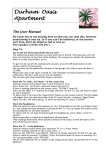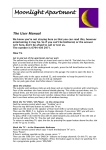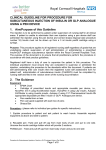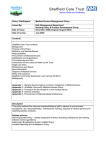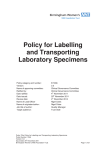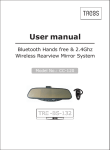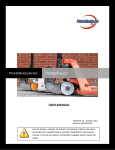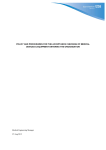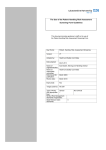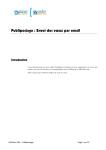Download Training in the Safe Use of Medical Devices Policy
Transcript
The Newcastle upon Tyne Hospitals NHS Foundation Trust Training in the Safe Use of Medical Devices Policy Versions No.: Effective From: Expiry Date: Date Ratified: Ratified By: 2.2 29 January 2015 30 September 2016 29 January 2015 Medical Device Steering Group 1 Introduction 1.1 This policy applies to all staff and their managers, who are required to use any type of medical device or therapeutic equipment as part of their work. It defines processes to ensure that staff are prepared and trained to safely operate/use equipment and that risk management systems are in place and used. 1.2 It is the Trust’s aim to ensure all staff using medical devices are competent in their use. To be competent is to be adequately trained, knowledgeable and capable of operating a device in a safe and effective manner. Education and training is essential to ensure that users of medical devices have appropriate knowledge and skills to operate medical devices. Only staff whose training and competence has been established should use any medical device independently. 1.3 For the purpose of this policy the term “Medical Device” encompasses devices as defined in MHRA Bulletin 17 “ Medical Devices and Medicine Products” (amended April 2006) and can be summarised as: “Any instrument, apparatus, appliance, material or other article, whether used alone or in combination, including the software necessary for its proper application, intended by the manufacturer to be used for human beings for the purpose of: • diagnosis, prevention, monitoring, treatment or alleviation of disease • diagnosis, monitoring, treatment, alleviation of or compensation for an injury or handicap • investigation, replacement or modification of the anatomy or of a physiological process • control of conception and which does not achieve its principal intended action in or on the human body by pharmacological, immunological or metabolic means, but which may be assisted in its function by such means.” Page 1 of 10 1.4 This purpose of this policy is to support safe practice. It does not constrain your clinical autonomy whatsoever, your own clinical judgement is to be exercised at all times and as such, clinical need/ emergency situations may over ride this policy. In exercising your own professional judgement, any alteration from this policy must be noted on a Datix incident form. This is important for legal accountability. 2 Scope 2.1 The Newcastle upon Tyne Hospitals NHS Foundation Trust aims to ensure that all clinical staff who operate diagnostic or therapeutic medical devices do so in a safe manner. 2.2 It is a Trust requirement that all clinical staff involved with the care of patients adhere to the principles of this policy. 3 Aims 3.1 To ensure that all staff operating diagnostic or therapeutic equipment can do so in a safe and effective manner. 3.2 That all staff are made aware of their responsibilities and are shown to be competent through generic and specific training programmes. 3.3 That adequate records are maintained or available at Directorate / Department level to account fully for training of all staff. 4 Duties (Roles and Responsibilities) 4.1 All Users of Medical Devices are responsible for: • Being familiar with their responsibilities under this policy and complying with them. • Ensuring their own competence in the use of an item of equipment and have successfully completed training where necessary to use the equipment independently. • Ensuring that on the completion of competency assessment, this information is recorded on the Trust Medical Devices training recording system. (Medical Devices Training (“My Devices”) recording system, accessible via the Learning Zone on the Trust Intranet). All users of Medical devices must adhere to the following principles before using any medical equipment: • Only use equipment identified on the Trust Medical Devices Inventory. • Do not use equipment unless trained / competent to do so. Page 2 of 10 • Identify their training requirements with line manager/supervisor. • Have completed necessary training and be deemed competent through self assessment or by a supervisor/trainer to operate independently. • Always visually inspect the equipment for signs of damage prior to use. • Know where the user manual / instructions are located. 4.2 All Managers of Users of Medical Devices are responsible for: • Ensuring that all equipment used is recorded on the Trust inventory. • Agreeing with individual members of staff which equipment from the inventory they are expected to use and the process for training and competency assessment, including frequency of updates. • Ensuring that training is made available for all users of devices where training is necessary, and that all equipment users are properly trained and competent. • Ensuring that users complete competency records for appropriate medical devices. 4.3 The Medical Devices Steering Group is responsible for: • Developing, implementing and monitoring compliance with this policy to ensure best practice. • Developing action plans where there is limited assurance of compliance with the policy. 5 Training 5.1 The ward/department manager (or nominated deputy) is required to compile an inventory of medical devices used in their area of responsibility. (Assistance to compile this inventory can be obtained by clicking on “Estates Log and Query” on the Trust intranet page, enter the department telephone number and select “Show Assets for your Department”. This inventory must be reviewed annually and/or when new equipment/devices are introduced into their area of responsibility. An example of documentation used to record this can be found as Appendix 1; alternatively the updated printed list from the intranet may be used. 5.2 A training needs review in relation to medical devices within the directorate should be undertaken by department managers (or nominated deputies) to identify training and competency needs at appointment, local induction and as part of annual reviews. This should include training updates as well as training on new devices. Consideration must be given to ensure competencies set meet individual staff needs. Personal Learning plans can be used to assist this process – see example attached as Appendix 2. Page 3 of 10 5.3 In the event of the appropriate training being unavailable from any source, this must be raised as a risk and included on the risk register. Until this issues has been resolved or rectified the equipment must not be used. 5.4 No medical equipment shall be used clinically and independently unless the operators who use the device(s) have received appropriate competency assessment/device training, which includes pre use checks to be made prior to the use of any medical device. 6 Competency Statements 6.1 It is essential that all practitioners using items of medical equipment independently are deemed competent in the safe and effective use of the equipment and can demonstrate this to their manager. 6.2 Training should be provided by a practitioner competent in the functions and operations of the device. An example of a competency statement is attached as Appendix 3. 6.3 Where a competency statement does not exist, expert users within areas can develop the statement for assessment, using the competency statement template on the EME Loan Library intranet site. This must then be authorised by the Matron / Clinical Manager for the area of use. The competency statement must then be posted by the authorising person on the EME Loan Library intranet site. 6.4 Should a member of staff be unable to demonstrate competence, their ward/department manager must arrange re-training before the individual can operate the medical device in a clinical environment independently. 6.5 Staff beginning employment with the Trust must complete the Trust corporate induction program where the following medical device related topics will be covered: • • • • • • Infection Control Fault Reporting Clinical Risk Competency Assessment Reporting procedure for adverse incidents Safe lifting & handling. 6.6 When a new medical device is introduced into an area, a review of device training needs should be undertaken and if required, staff should receive training or competency instruction before using the equipment. All training and competency assessment information should be recorded on the Trust Medical Devices Training (“My Devices”) recording system, accessible via the Learning Zone on the Trust intranet. 6.7 Reference should be made to the Management of Medical Devices Policy. Page 4 of 10 7 Equality and Diversity The Trust is committed to ensuring that, as far as is reasonably practicable, the way services are provided and the way staff are treated reflects their individual needs and does not unlawfully discriminate against individuals or groups. This policy has been properly assessed. 8 Monitoring the Compliance/Effectiveness of this Policy Standard / process / issue Monitoring and audit Method By Committee Frequency Directorate activity / compliance with processes for identifying which staff are authorised to use the equipment Via a quarterly report on training activity to the Medical Devices Steering Group “My Devices” System Manager The Medical Devices Steering Group Quarterly Process for determining training requirements and any identified training needs are met Sample spot check Medical Device Steering Group The Medical Devices Steering Group Annual Monitoring of themes and trends relating to Medical Device incidents, accidents and near misses Via a quarterly report on incident activity relating to Medical Devices to the Medical Devices Steering Group CGARD The Medical Devices Steering Group Quarterly Medical Device Training activity Via an annual report on training activity to the Trust Education Board The Chair of the Medical Device Steering Group The Medical Devices Steering Group Annual 9 Consultation and Review of this Policy This policy has been reviewed in consultation with the EME Services Officer, Medical Equipment Loan Library Manager, Risk Management Quality and Safety Lead, Head of Unit - Medical Physics and the Medical Device Steering Group. 10 Bibliography NHSLA “Risk Management Standards for Acute Trusts”, published by the NHS Litigation Authority (January 2010). MHRA Devices in Practice (August 2008). Author: Review by: Chair of Medical Devices Steering Group EME Services Officer RVI Page 5 of 10 Appendix 1 Medical Device Inventory for wards/departments Ward: Date Site: Equipment (specify type, manufacturer & model) Directorate/Department: Potential operators for this equipment Page 6 of 10 Managers Signature Appendix 2 Personal Learning Plan Name: What do I want to learn? What will I do to achieve it? Department: What resources/ support will I need? How will I know I have succeeded? Page 7 of 10 Date: Target Date Review Appendix 3 Self Assessment/ Peer Assessment Competency statement for: Abbott FreeGo feeding Pump HIGH RISK DEVICE – DO NOT USE this item until you have received training in its operation Surname Forename(s) Job Title / Designation Personnel Number Directorate Ward / Department Self verification/ Peer assessment of competence is undertaken by assessment against the following statements: These statements are designed to indicate competence to use this device. Responsibility for use remains with the user, so if you are in any doubt regarding your competence to use the device, you should seek education to bring about improvement. Various methods including, self-directed learning and formal training may be initiated. Carry out an initial assessment. You must be able to answer “yes” to all the questions before considering yourself to be competent. If you are not competent, instigate learning & repeat self-verification. Peer assessment will involve the practitioner demonstrating competence against the following statements to an experienced colleague who had already undergone assessment. Self Assessment / peer assessment statements Initial Assessment Y/N 1. Identify clinical use for the FreeGo feeding pump 2. Explain / demonstrate pre-use safety checks/ precautions /setting up Connect power supply to the pump Identify correct consumables to be used with the pump Explain correct positioning of the device Demonstrate loading of the giving set Turn the pump on 3. Demonstrate priming the giving set manually 4. Demonstrate priming the giving set automatically 5. Explain /identify the control dial functions and touch panel control keys including Power off/Charge Set rate Set dose Run Hold Volume fed Clear volume Lock feature Adjusting the alarm volume and display light 6. Demonstrate attaching the set to the patient and initiating feeding 7. Explain all screen information obtained during feeding including how to rectify alarms Occlusion – into pump Battery – battery empty Occlusion - out of pump DOOR – open ATTN - pump on hold NO – cassette Page 8 of 10 Y/N Y/N Y/N Y/N Y/N Y/N Final Assessment Y/N BATT – low battery Lock – pump locked ER# # - System fail FEED - Empty DOSE – Done 8. State battery charge times and how long a fully charged battery will last 9. Demonstrate storage and cleaning of equipment during and after use 10. Explain policy / procedure to be taken in the event of an incident or pump malfunction Self assessment statement: Having said “yes” to all the questions above & taken into account my personal assessment of my competence with the device, I declare that: I am competent to use this device without further training Signature: Date: I require further training before I can use this device in a competent manner Signature Date: Indicate how you plan to meet your learning needs Peer / Trainer Assessment statement: I have peer assessed ………………………………………………………………… and they are competent to use this device without further training Signature: Date: Print name: Keep this form in your personal portfolio or training record. Ensure that your manager has seen the form & entered details of your competence in their records. Page 9 of 10 THE NEWCASTLE UPON TYNE HOSPITALS NHS FOUNDATION TRUST IMPACT ASSESSMENT – SCREENING FORM A This form must be completed and attached to any procedural document when submitted to the appropriate committee for consideration and approval. Policy Title: Training in the Safe Use of Medical Devices Policy 1. Does the policy/guidance affect one group less or more favourably than another on the basis of the following: (* denotes protected characteristics under the Equality Act 2010) Race * Ethnic origins (including gypsies and travellers) Nationality Gender * Culture Religion or belief * Sexual orientation including lesbian, gay and bisexual people * Age * Disability – learning difficulties, physical disability, sensory impairment and mental health problems * Gender reassignment * Marriage and civil partnership * Is there any evidence that some groups are affected differently? If you have identified potential discrimination which can include associative discrimination i.e. direct discrimination against someone because they associate with another person who possesses a protected characteristic, are any exceptions valid, legal and/or justifiable? Is the impact of the policy/guidance likely to be negative? (If “yes”, please answer sections 4(b) to 4(d)). If so can the impact be avoided? What alternatives are there to achieving the policy/guidance without the impact? Can we reduce the impact by taking different action? Policy Author: Yes/No? 2. 3. 4(a). 4(b). 4(c). 4(d) Jackie Moon, Chair of Medical Devices Steering Group You must provide evidence to support your response: No No No No No No No No No No No No No No N/A N/A N/A Comments: Name and Designation of Person responsible for completion of this form: J P Stephenson, EME Services Officer. Names & Designations of those involved in the impact assessment screening process: Medical Device Steering Group Action Plan due (or Not Applicable): N/A Date: 11/09/2013 (If any reader of this procedural document identifies a potential discriminatory impact that has not been identified on this form, please refer to the Policy Author identified above, together with any suggestions for the actions required to avoid/reduce this impact.) For advice on answering the above questions please contact Frances Blackburn, Head of Nursing, Freeman/Walkergate, or, Christine Holland, Senior HR Manager. On completion this form must be forwarded electronically to Steven Stoker, Clinical Effectiveness Manager, (Ext. 24963) [email protected] together with the procedural document. If you have identified a potential discriminatory impact of this procedural document, please ensure that you arrange for a full consultation, with relevant stakeholders, to complete a Full Impact Assessment (Form B) and to develop an Action Plan to avoid/reduce this impact; both Form B and the Action Plan should also be sent electronically to Steven Stoker within six weeks of the completion of this form. IMPACT ASSESSMENT FORM A October 2010










